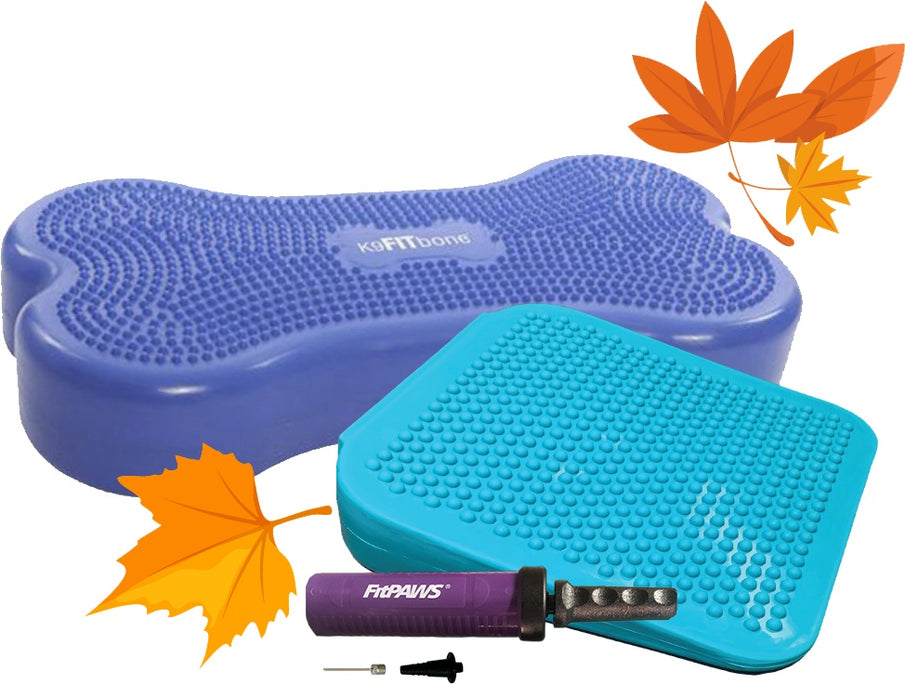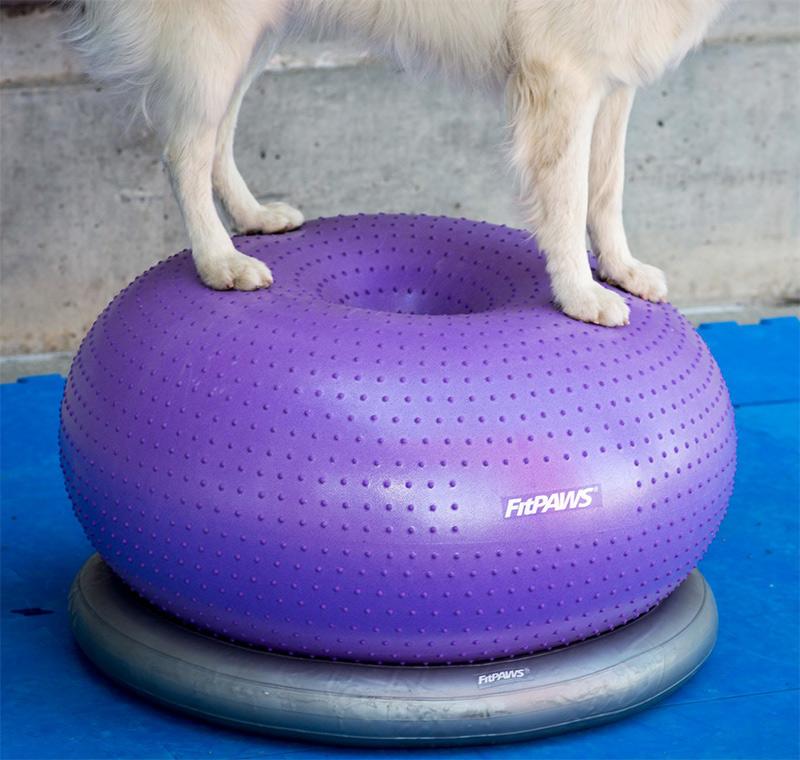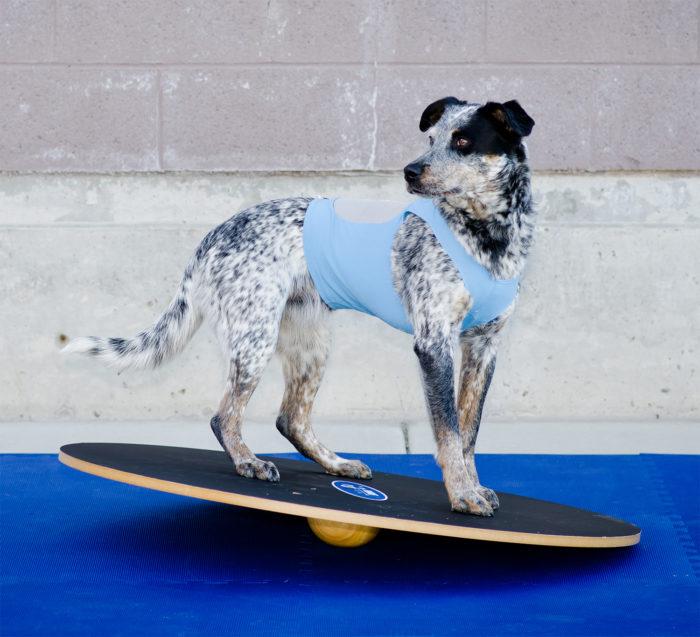Dog Agility
Dog agility is a sport we've never tried. I wanted to, Simone would have loved it - but she got kicked out of class before it ever started because of the teacher's bias that Malamutes are not good agility dogs. Nothing could be further from the truth. I have many friends whose Malamutes LOVE agility. Agility is a sport where the handler directs the dog through an obstacle course - the goal is speed and accuracy. The dogs run off leash just for the joy - no squeakies or food allowed. You aren't allowed to touch the dog or obstacles and must control the dog by voice, movement, and body signals only so off leash control is imperative.
I also think if we tried again, I'd do UKC agility over AKC agility mainly because they have so many more creative jumps and contact objects....variety is the spice of life!
The course is made up of standard obstacles laid out by the judge in various patterns. The ground can be grass, dirt, rubber or matting - sometimes obstacles are marked for the order they must be completed. The course is intentionally hard enough that the dog can't do it without human direction. Because each course is different, handlers are allowed a short walk-through, sans dog, before the competition starts. Because dogs and people think differently, it may take some time to plan your optimal moves with consideration to how your dog will want to run it.
The walk-through is important because the path takes all kinds of crazy turns, may use the same obstacle more than once or the handler must be able to tell the dog which obstacle to take when they are so close there's a choice. Working with the dog may be close or far, depending on the obstacle. Sometimes course maps are available to handlers to help them plan their strategy.
During a run, the dog and handler get one opportunity to attempt the coarse successfully. The handler generally runs near the dog, using spoken commands and body language to tell the dog what to do. Speed counts as much as accuracy, especially at high levels of competition, and so the dog MUST be fast. (the handler too, so hopefully you can run and direct at the same time without falling on your face!)
Scoring is based on how many faults occur. A fault is knocking down a bar jump, refusing to go up a ramp....and time faults mean you have to hit each obstacle within a certain period of time.
Fastest most accurate dog wins of course!
Descriptions of the various obstacles:
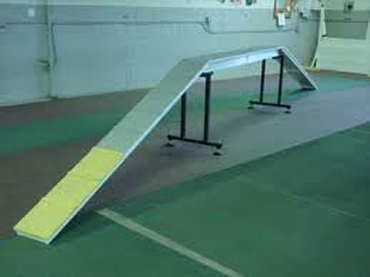
Dogwalk
Three 8 to 12 ft (2.4 to 3.7meters) planks, 9 to 12 inches (23 to 30 cm) wide, connected at the ends. The center plank is raised to about 4 feet (1.2meters) above the ground, so that the two end planks form ramps leading up to and down from the center plank. This obstacle also has contact zones. Many sanctioning organizations require that dogwalks have low profile, narrow, horizontal slats all along their length to assist the dog's grip going up and down; other organizations prohibit slats; and many organizations now allow or require a rubberized surface.

Teeter-totter or Seesaw
A 10-to-12-foot (3.0 to 3.7meters) plank pivoting on a fulcrum, much like a child's seesaw. It is constructed slightly off-balance so that the same end always returns to the ground. This is done either by placing the support slightly off-center or else weighting one end of the board. This obstacle also has contact zones. However, unlike the other contact obstacles, the teeter-totter does not have slats. Many organizations now allow or require a rubberized surface. The balance point and the weight of the plank must be such that even a tiny dog, such as a can cause the high end of the teeter-totter to descend to the ground within a reasonable amount of time, specified by the sanctioning organization's rules (usually about 2 seconds). Smaller dogs get more time to run a course, and this is one reason why it can take them longer than it takes larger dogs.
BUY PREMADE TEETERS


Kerbl Agility Rocker, 60 x 18 x 12 cm Kerbl Agility Rocker, 60 x 18 x 12 cm

Tunnel. A vinyl tube, 10 to 20 feet (3.0 to 6.1meters) long and about 2 feet (61 cm) in diameter, through which the dog runs. The tunnel is constructed of flexible vinyl and wire, such that it can be configured in a straight line, or in a variety of curves.
BUY TUNNELS & ACCESSORIES

Topmart Dog Playing Tunnel 16.5ft Agility Pet Training Tunnel Tube with 2 Frisbees and Carry Bag for Cats Dogs Outdoor Training
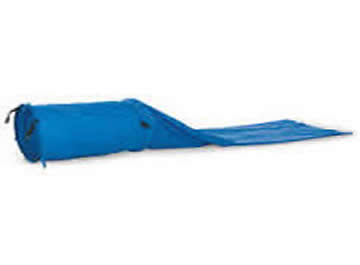
Collapsed Tunnel (or chute or cloth tunnel)
A barrel-like cylinder with a tube of fabric attached around one end. The fabric extends about 8 to 12 feet (2.4 to 3.7meters) and lies closed until the dog runs into the open end of the chute and pushes his way out through the fabric tube.
BUY SPECIALTY TUNNELS

Lixit Dog Agility Closed Tunnel - 16 Feet - 24 inch diameter

Jump (or hurdle)
Two uprights supporting a horizontal bar over which the dog jumps. The height is adjusted for dogs of different heights. The uprights can be simple stanchions or can have wings of various shapes, sizes, and colors. Training Jumps are for if you are just getting started in Agility or space is limited. They are lighter weight than competition jumps, but durable.
BUY HURDLES


Crown Sporting Goods Speed Agility Training Hurdles, Pack of 5, Choose from 6-inch, 9-inch, or 12-inch by
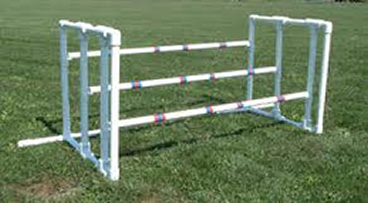
Double and triple jump (or spread jump) Two uprights supporting two or three horizontal bars spread forward or back from each other. The double can have parallel or ascending horizontal bars; the triple always has ascending bars. The spread between the horizontal bars is sometimes adjusted based on the height of the dog. It is sometimes called a "Spread Jump". A 'Practice Triple Jump' is similar to the 'Competition Triple Jump' in dimensions and function so the price and full function makes it a great choice for backyard practice use.
BUY JUMPS
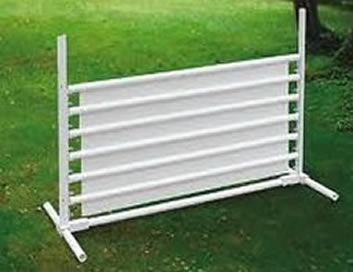
Panel jump
Instead of horizontal bars, the jump is a solid panel from the ground up to the jump height, constructed of several short panels that can be removed to adjust the height for different dog heights.
BUY PANEL JUMPS


Affordable Agility Panel Jump

Broad jump (or long jump)
A set of four or five slightly raised platforms that form a broad area over which the dog must jump without setting their feet on any of the platforms. The length of the jump is adjusted for the dog's height. The boards slightly different sizes, both in ascension and in length, so they "nest" inside each other for compact storage and portability. The practice jumps range from 36 inches to 41 inches, slightly smaller than a competition broad jump. Depending on your dog's height, you will train with two to four boards.
BUY BROAD JUMPS


Complete Practice Broad Jump set includes the jump boards as well as 4 marker poles The boards are variegated in size, both in ascension, and in length Assembled sections are ready for use, just set the marker poles in the corners and go Panels conveniently nest inside each other for compact storage and portability
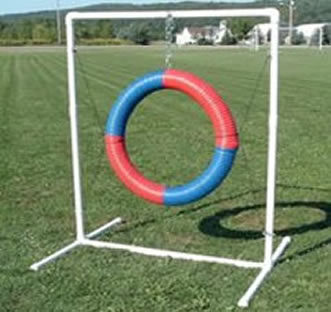
Tire jump
A shape roughly the size of a tire (18 inches (46 cm) to 24 inches (61 cm) inside diameter), suspended in a frame. The dog must jump through the opening of the "tire"; like other jumps, the height is adjusted for dogs of different sizes. The tire is usually wrapped with tape both for visibility and to cover any openings or uneven places in which the dog could catch. Many organizations now allow or require a so-called displaceable or breakaway tire, where the tire comes apart in some way if the dog hits it hard enough.The tire is made of hollow plastic tubing, attached at the top with chain, and held secure on the sides (from rocking) with a sliding shock-cord support. By simply unclipping the top of the chain and moving the tire up and down, you can quickly adjust it to any height. You have a choice of tire sizes, 24" (AKC / CPE), or 20" (USDAA).
BUY TIRE JUMPS


DogSport Agility Tire Jump (Hoop Jump)
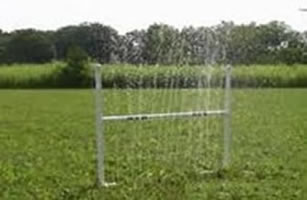



UKC agility allows a variety of hurdles not found in other agility organizations: bush hurdle, high hurdle, log hurdle, picket fence hurdle, rail fence hurdle, long hurdle, window hurdle, and water hurdle, sway bridge, log jump, window hurdle, and swing plank.

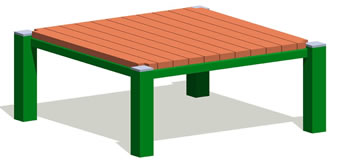
A Pause Table is an elevated square platform about 3-foot-by-3-foot (1-meter-by-1-meter) square onto which the dog must jump and pause, either sitting or in a down position, for a designated period of time which is counted out by the judge, usually about 5 seconds. The height ranges from about 8 to 30 inches (20 to 76 cm) depending on the dog's height and sponsoring organization. A Contact Zone Training Hoop aids in teaching your dog straight on approaches and exits off contact obstacles. To hit the contact zones without jumping off the obstacle. You can use the Training Hoop with A-Frames, Teeters and Dog Walks.
BUY CONTACT OBSTACLES

Blue-9 Pet Products The KLIMB Dog Training Platform and Agility System QuiKonnect - Blue-9's proprietary QuiKonnect locking tab that allows you to securely create multi-unit platforms of virtually any size
 The A-Frame uses two planks, or sheets of plywood and is typically 36" wide. A hinge at the top allows base width and angle to be adjusted for the breed group running the trial. There are contact points on both sides of the obstacle, entry/exit, that your dog must hit. If a dog leaps off half way down the exit side of the obstacle for example, it will miss the contact zone and incur a time penalty.
The A-Frame uses two planks, or sheets of plywood and is typically 36" wide. A hinge at the top allows base width and angle to be adjusted for the breed group running the trial. There are contact points on both sides of the obstacle, entry/exit, that your dog must hit. If a dog leaps off half way down the exit side of the obstacle for example, it will miss the contact zone and incur a time penalty.
BUY A FRAMES


All metal design with rubber surface Available in 7' and 9' sizes Blue with yellow contact zones Can be folded for transportation or storage
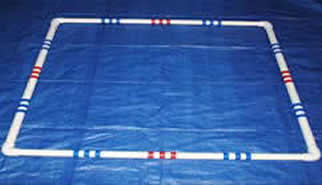
 Weave poles
This is a series of 5 to 12 upright poles, each about 3 feet (0.91meters) tall and spaced about 24 inches (61 cm) apart (spacing for AKC was 21 inches (53 cm) until it was changed in January 2010. The extra three inches was to relieve stress on the dog's back.), through which the dog weaves. The dog must always enter with the first pole to his left, and must not skip poles. For many dogs, weave poles are one of the most difficult obstacles to master. They are a great indoor and outdoor training tool. Training poles slant out allowing you to start with the "weave-a-matic" training method. As your dog's proficiency improves, you can bring the poles closer together. Once your dog masters the weave poles, they can be set in a straight up and down position.
Weave poles
This is a series of 5 to 12 upright poles, each about 3 feet (0.91meters) tall and spaced about 24 inches (61 cm) apart (spacing for AKC was 21 inches (53 cm) until it was changed in January 2010. The extra three inches was to relieve stress on the dog's back.), through which the dog weaves. The dog must always enter with the first pole to his left, and must not skip poles. For many dogs, weave poles are one of the most difficult obstacles to master. They are a great indoor and outdoor training tool. Training poles slant out allowing you to start with the "weave-a-matic" training method. As your dog's proficiency improves, you can bring the poles closer together. Once your dog masters the weave poles, they can be set in a straight up and down position.BUY WEAVE POLES


Agility Weave Poles Adjustable 6 Pole Set with Carrying Case and Grass Stakes Assembles in Seconds Fully Adjustable, can be configured as 2 by 2's Straight or Offset Configuration Meets Competition Guidelines 2 Foot Centers, Flat to the Ground Base


Affordable Agility Lattice Jump Wing
BUY WOBBLE BOARDS


Dog Agility Equipment Wobble Board 22" | Blue
BUY A LADDER


Do More With Your Dog Rainbow Ladder
Some tips for doing Agility (especially beginners!)
- ALWAYS be positive and end on a positive note. This must the the most fun thing he ever does and he'll give you everything.
- NEVER say "No". If your dog doesn't do an obstacle correctly, say in a positive voice, "Oops, let's try this again", and go back to the beginning. Never scowl or act disappointed. Your dog will pick up on your moods and can either "freeze", or will keep making the same mistake. It's better to take some baby steps backwards and try not to let your dog fail more than twice in a row. If your dog keeps knocking the bar, lower it. If he keeps skipping a weave pole, go slower and guide him better. You'll also want to make potty time BEFORE you do all that running. An accident in the ring will get you eliminated.
- ALWAYS be clearly expressive. This is hard for some people, but your dog cannot guess what you want. The dog needs to be able to read your instructions clearly...because obstacles are not always in an expected order or line at agility trails. Sometimes "traps" are set to make it more challenging. Body language is very important to your dog, who is picking up on everything. If you say one thing and your body says something else, you're going to confuse the dog. Give him lost of warning too...no last second instructions. Stay ahead of your dog enough to clearly show him the next obstacle.
- ALWAYS give praise for a job well done. This includes giving treats or a favorite toy after doing an obstacle correctly. Then, as your dog seems to have no problem doing an obstacle correctly, add another one, then give the praise and reward. If your dog seems to be going slower or is distracted, go back to giving treats after a couple of obstacles. Keep him interested, focused, and most of all motivated!

